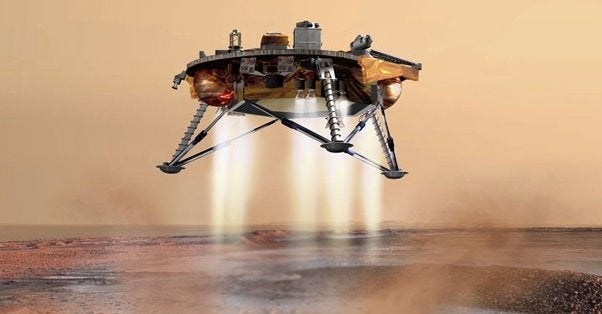
The US space program is in the midst of a historic revolution. The White House's plan to hand over low Earth orbit activities to the rising US commercial space sector and focus the agency on far ranging exploration goals is a complete re-set of our space program.
In the last months, it was assaulted by forces trying to keep their post Apollo gravy train intact. The grass roots activists and supporters of what I call the Frontier movement in both parties fought back and stalled efforts by some members of the House and Senate to roll back the president's plans in an amazing demonstration of the coming of age for a movement now almost 30 years old.
This fight is between the old NASA aerospace industrial complex and those who see space as a place rather than a program. It is led by a new generation of space entrepreneurs and commercial firms taking on what used to be government roles in space while also developing whole new industries including tourism, hotels, private laboratories and eventually even energy production, space manufacturing and mining of resources. All of which are designed to do one thing, allow us to live and settle on this new frontier.
Rather than the old way of having to pick a single program, destination or set of technologies as a national goal and have that goal reached (or not) by government employees and then abandoned for the next one, the Frontier movement is about being able to reach any destination, develop new and amazing technologies that will let us not only explore them, but travel to them, stay where we go, harvest the resources we discover there, and make of many of them new homes for humanity, using a shared set of capabilities and infrastructure with each element of our society contributing to the whole by doing what it does best.
Although some with their heads stuck in the sand of past times can't see it, it is a positive change, a true shift in the concept of how and why we explore space. But it need not be a battle between science and human exploration, or government exploration and private commercial plans. By simply re-defining the relationship and overall goals between these two areas of our society, we will be able to throw open the doors to space in a way dreamed of only in the worlds of science fiction, a way forward which will literally change the shape of human civilization in the decades and centuries to come.
I first came up with this concept a few years ago, to help me simplify in my own mind the relationship between NASA and the potential civilian space activities needed to accomplish this task. Popular Science picked up on it and since then it has slowly begun to take hold in our field. Perhaps by using it, you too can understand what this revolution is about, and how we might just be on the "edge" of something truly incredible.
In the "Frontier Model," the Earth sits at the center of an expanding bubble of life. In this admittedly human centric view, the universe is broken down into two main areas. Inside the bubble is the "Near Frontier" -- the outer edge being where life has perhaps not yet taken hold, but has at least begun to probe. Outside of the bubble is the "Far Frontier," which includes the universe (any place humans have not yet been). If one is to gauge the edge of this bubble by where humans have actually been or visited in person, then the Moon represents that edge. Keep in mind, it is a bubble, and it is (or should be) expanding.
The Far Frontier beyond the Moon is the domain of exploration at the level of pure science and what I call the Lewis and Clark function of our government, wherein we pool our financial resources and send out people and machines to tell us what is there. It is the domain where "profits" and the immediate return on our investment are defined in a cultural sense, such as science and general knowledge but also wonder, prestige and inspiration. For now the domain of Voyager, the Mars landers, and the host of other vehicles we have sent out to explore and report to us, with any luck it will soon be where the next astronaut explorers travel on missions of discovery as they reach outwards to Mars and the asteroids.
From the edge of the bubble inwards, or shall we say from the Moon inwards today, we have the "Near Frontier". This is where human explorers have already "been," and in the most general sense where their work is "done". In other words, the closer one gets to home, the more often are one's paths traveled, the more well known is the terrain, the lower the risk and the more routine one's activities become.
And this is entirely appropriate. As I said, as one moves closer to the Earth in the Near Frontier, operations and activities become more and more routine, and interestingly, so does the viability of plans to create useful economic activities based on the resources one has discovered. The possible returns on investment expand beyond cultural. For example, the further inside the edge of the frontier one is, the more sense a business plan makes based on use of the resources or domain available, where the profit can be financial, and begin to drive the formation of new businesses based on utilizing the space environment or harvesting its resources - be they material, energy based or location based - such as entertainment, tourism or using the properties of the location such as micro gravity etc.
In a functioning Frontier oriented space program, the government's explorers are not only aware of their role as surveyors and harbingers of an expanding civilization, they operate from it as a core driver and manifest its implementation in all they plan and do - as It is One of the Core Reasons for What They Do.
In other words, the Lewis and Clarks of space at NASA and the other government space agencies of the world should know they are the leading edge of a human wave and do their work in a way that enhances and enables those who will follow. They don't begrudge the settlers and companies who come behind them, they don't compete with them, and they certainly don't fight or attack them or their motives. Quite the opposite, they are doing their job partially because it is in the interest of the people funding them to gain an understanding of what is out there beyond the edge.
If we grow the orbital industrial infrastructure needed here in the Near Frontier by nurturing large-scale commercial and industrial activities and combining them with new exploration missions out into the Far Frontier and intelligent investments at the government level in deep space transportation and resource utilization technologies that can be used to push out the edge of that frontier, the entire Solar System will be opened to humanity, including the Moon, Mars and all the spaces and places between and beyond.
